Training your delts is a fundamental part of strengthening and defining your shoulders. Whether you are a workout pro or designing your first training plan, the exercises below will help you meet your fitness goals.
cable upright row
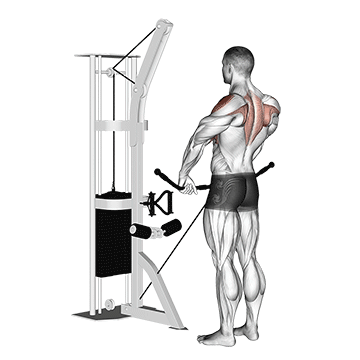
To perform the cable upright row, start by standing in front of a cable machine. Set the pulley to the lowest level and attach a straight bar to the cable.
Stand up straight and grab the bar with an overhand grip, hands shoulder-width apart. This is your starting position.
Pull the bar up towards your chin, keeping it close to your body. Your elbows should drive the motion, and should always be higher than your forearms. Continue to lift the bar until it nearly touches your chin.
Pause for a moment at the top of the movement, then slowly lower the bar back to the starting position.
Ensure your back is straight and your core is engaged throughout the exercise. Avoid using your back or legs to lift the weight; your arms and shoulders should be doing the work.
Repeat for the desired number of reps. This exercise primarily targets the deltoids, but also works the traps and biceps.
Remember to use a weight that is challenging but allows you to maintain proper form. If you're new to this exercise, start with a lighter weight to get the movement down, then gradually increase the weight as you get stronger.
cable supine reverse fly
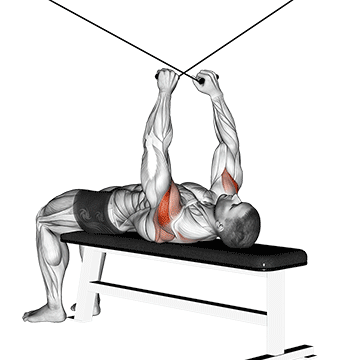
To perform the cable supine reverse fly, follow these steps:
1. Set up the cable machine by adjusting the pulleys to the highest level and attaching a single handle to each side.
2. Position a flat bench in the middle of the cable machine, perpendicular to the pulleys.
3. Lie down on the bench on your back, with your head towards one pulley and your feet towards the other.
4. Reach up and grab the handles with each hand. Your palms should be facing each other and your arms should be extended out to the sides, creating a T shape with your body.
5. Keeping your arms slightly bent, pull the handles down and across your body, bringing them together over your chest. This is the starting position.
6. Slowly reverse the movement, allowing your arms to move back out to the sides until they're in line with your shoulders. This should be done in a controlled manner, feeling the stretch in your delts.
7. Pause for a moment at the top of the movement, then repeat the exercise for your desired number of repetitions.
Remember to keep your back flat against the bench and your core engaged throughout the exercise to protect your spine. Also, ensure that the movement is controlled and that you're not using momentum to swing the weights.
cable standing shoulder external rotation
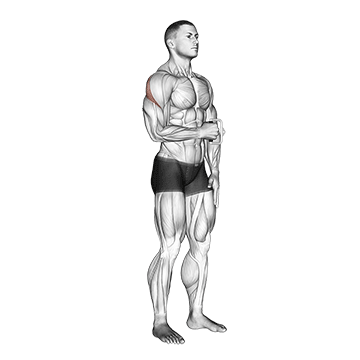
1. Start by setting up the cable machine with a single handle attachment at the lowest setting.
2. Stand sideways to the cable machine, with your right side closest to the machine if you're working your right arm first.
3. Grab the handle with your right hand and step away from the machine until your arm is fully extended.
4. Stand with your feet shoulder-width apart for balance. Bend your knees slightly and engage your core.
5. Bend your right elbow to a 90-degree angle, keeping your upper arm close to your body. This is your starting position.
6. Slowly rotate your forearm outward, away from your body, while keeping your elbow tucked into your side.
7. Rotate your arm as far as comfortably possible, or until your forearm is in line with your body.
8. Hold this position for a moment, then slowly return to the starting position.
9. Repeat this movement for your desired number of repetitions.
10. Once you've completed your set, switch to your left side and repeat the exercise.
Remember to keep your movements slow and controlled, focusing on the rotation of your shoulder. Avoid using your wrist or forearm to pull the cable, as this can lead to injury.
cable standing rear delt row (with rope)
_shoulder_360.gif)
1. Start by setting up the cable machine. Attach a rope handle to the low pulley of the cable machine.
2. Stand facing the cable machine with your feet shoulder-width apart.
3. Bend slightly at the knees and lean forward from your hips, keeping your back straight. Your torso should be almost parallel to the floor.
4. Reach forward and grab the rope handle with both hands. Your palms should be facing each other and your arms should be fully extended in front of you. This is your starting position.
5. Pull the rope towards your body, keeping your elbows flared out to the sides. Your hands should come towards your ears.
6. Squeeze your shoulder blades together at the top of the movement, focusing on the contraction in your rear delts.
7. Slowly extend your arms back to the starting position, maintaining control of the movement.
8. Repeat for the desired number of repetitions.
Remember to keep your core engaged throughout the exercise to maintain balance and stability. Also, ensure that the movement is controlled and that you're not using momentum to pull the rope towards you. The focus should be on the muscle contraction and not on the weights you're lifting.
cable standing cross-over high reverse fly
1. Start by adjusting the pulleys on the cable machine to the highest level. Attach a handle to each pulley.
2. Stand in the middle of the cable machine, facing away from it. Grab the left handle with your right hand and the right handle with your left hand, crossing your arms in front of you. This is your starting position.
3. Keep your feet shoulder-width apart and slightly bend your knees for stability. Maintain a straight back and engage your core.
4. With a slight bend in your elbows, pull the handles down and out to your sides in a wide arc until they reach shoulder level. You should feel a squeeze in your shoulder blades.
5. Hold this position for a second, focusing on the contraction in your delts.
6. Slowly reverse the movement, allowing the cables to pull your arms back to the starting position. This should be done in a controlled manner to maintain tension in the muscles.
7. Repeat the exercise for the desired number of repetitions.
Remember to keep your body stationary throughout the exercise, moving only your arms. The movement should be initiated from the shoulders, not the arms. Also, avoid using too much weight as it can lead to improper form and potential injury.
cable shoulder press
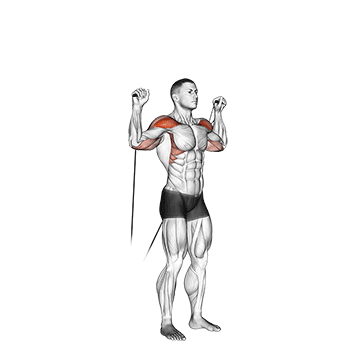
To perform the cable shoulder press, start by adjusting the cable machine to your desired weight. Stand in the middle of the cable machine with your feet shoulder-width apart.
Reach out and grab the handles of the cable machine, ensuring your palms are facing forward and your hands are at shoulder level. This is your starting position.
Push the handles upwards until your arms are fully extended above your head. Make sure to keep your back straight and your core engaged throughout the movement.
Pause for a moment at the top of the movement, then slowly lower the handles back down to the starting position.
Ensure that you control the movement throughout the entire exercise, don't let the weights control you.
Repeat this movement for your desired number of repetitions.
Remember to keep your movements smooth and controlled, and to keep your core engaged throughout the exercise to protect your lower back.
This exercise primarily targets your deltoids, but also works your triceps and upper back. Adjust the weight as needed to ensure you can perform the exercise with proper form.
cable seated shoulder internal rotation
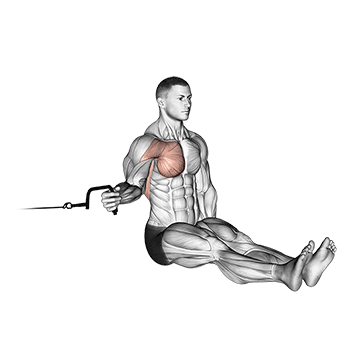
1. Start by adjusting the cable machine to the lowest setting. Attach a single handle to the cable.
2. Sit down on a bench or chair that is positioned sideways to the cable machine. Your right side should be closest to the machine if you're working your right shoulder, and vice versa.
3. Grab the handle with your closest hand (right hand if you're working your right shoulder, left hand if you're working your left shoulder). Your arm should be bent at a 90-degree angle, and your elbow should be tucked into your side.
4. Slowly rotate your forearm towards your body, pulling the cable handle across your body. Keep your elbow tucked into your side throughout the movement.
5. Pause for a moment when your forearm is as close to your body as it can get, then slowly return to the starting position. This is one repetition.
6. Complete your desired number of repetitions, then switch sides and repeat the exercise with your other arm.
7. Remember to keep your back straight and your core engaged throughout the exercise. Also, ensure that the movement is controlled and steady, avoid any jerky or rapid movements.
8. For optimal results, perform 3 sets of 10-15 repetitions on each side.
Remember, the key to this exercise is the rotation of the shoulder, not the movement of the arm. The elbow should remain stationary, acting as a hinge for the rotation.
cable seated rear lateral raise
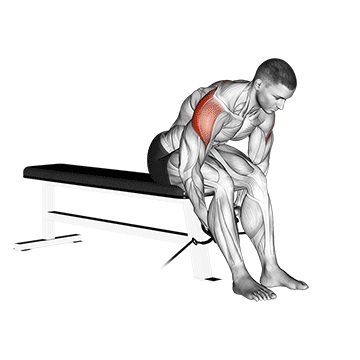
1. Start by adjusting the cable machine to the lowest setting and attach a D-handle to each cable.
2. Sit on the bench facing the cable machine, with your feet flat on the floor for stability. Grab the left cable with your right hand and the right cable with your left hand. This is your starting position.
3. Keeping your back straight and your core engaged, pull the cables out to your sides and slightly back, focusing on using your rear deltoids to perform the movement. Your arms should be slightly bent at the elbows.
4. Continue to pull the cables until your arms are parallel with the floor. Hold this position for a moment, squeezing your shoulder blades together.
5. Slowly return the cables to the starting position, maintaining control of the movement to ensure your muscles are engaged throughout the entire exercise.
6. Repeat this movement for the desired number of repetitions.
Remember to keep your movements slow and controlled, focusing on the muscle contraction and not on the weights you are lifting. Avoid using your back or momentum to lift the weights; your shoulders should be doing the work.
cable rear delt row (with rope)
_Shoulders_360.gif)
1. Start by setting up the cable machine with a rope attachment at the bottom of the pole.
2. Stand facing the cable machine, feet shoulder-width apart, and bend slightly at the knees.
3. Lean forward from your hips until your torso is almost parallel to the floor. Keep your back straight and your core engaged.
4. Grab the rope with both hands, palms facing each other. Your arms should be fully extended in front of you, and your hands should be in line with your shoulders.
5. Pull the rope towards your body, keeping your elbows high and wide. Squeeze your shoulder blades together as you pull.
6. Pause for a moment when your hands reach your chest, then slowly extend your arms back to the starting position.
7. Repeat this movement for your desired number of repetitions.
Remember to keep your core engaged throughout the exercise to protect your lower back, and ensure your movements are slow and controlled to fully engage your delt muscles.
cable rear delt row (stirrups)
_Shoulders_360.gif)
1. Start by setting up the cable machine with stirrups at a low setting.
2. Stand facing the cable machine, feet shoulder-width apart, and slightly bend your knees for stability.
3. Grab the stirrups with both hands, ensuring your palms are facing each other.
4. Step back from the machine until your arms are fully extended in front of you. This is your starting position.
5. Pull the stirrups towards you, keeping your elbows high and out to the sides. Your hands should come up to about shoulder level.
6. Squeeze your shoulder blades together as you pull, focusing on using your rear delt muscles.
7. Hold this position for a moment, then slowly return to the starting position.
8. Repeat this movement for your desired number of reps.
Remember to keep your back straight and your core engaged throughout the exercise to protect your spine. Also, ensure that the movement is controlled and that you're not using momentum to pull the stirrups.
cable one arm lateral raise
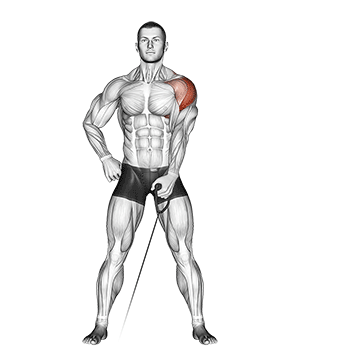
To perform the cable one arm lateral raise, start by setting the cable machine to the lowest height. Attach a single handle to the cable machine.
Stand sideways to the machine, feet shoulder-width apart, with the cable machine on your right side. Grab the handle with your right hand, keeping your arm fully extended and your palm facing down. This is your starting position.
Slowly lift your arm to the side, keeping it straight, until it is parallel with the floor. Ensure your torso remains stationary and your movement is controlled. You should feel a contraction in your deltoid muscle at the top of the movement.
Pause for a moment at the top, then slowly lower your arm back to the starting position.
Repeat this movement for your desired number of repetitions, then switch sides to work your left deltoid.
Remember to keep your core engaged and your back straight throughout the exercise. Avoid using your body momentum to lift the weight; your deltoid should be doing the work.
This exercise can be performed in sets of 10-15 repetitions, depending on your fitness level and goals.
cable lateral raise
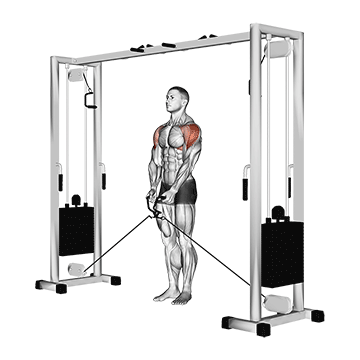
1. Start by setting up the cable machine. Attach a single handle to the low pulley cable.
2. Stand sideways to the machine, making sure your left side is closest to it. Grab the handle with your right hand, keeping your arm fully extended and your feet shoulder-width apart.
3. Keep your back straight, your core engaged, and your knees slightly bent. This will be your starting position.
4. Slowly lift the cable handle out to your side, keeping your arm straight. Continue to lift until your arm is parallel with the floor and your body forms a T shape.
5. Pause for a moment at the top of the movement, then slowly lower the handle back down to the starting position.
6. Repeat this movement for the desired number of repetitions. Once you've completed your set, switch sides so that your right side is now closest to the machine and repeat the exercise with your left arm.
7. Remember to keep your movements controlled, don't let the weight pull your arm down quickly. The slower the movement, the more your delts have to work.
8. Avoid using your back or tilting your body to lift the weight. The movement should be initiated by your shoulder lifting the weight to the side.
9. Keep your abs engaged throughout the exercise to help maintain balance and stability.
10. Repeat for the desired number of sets.
cable kneeling rear delt row (with rope) (male)
-(male)_Shoulder_360.gif)
1. Start by setting up the cable machine with a rope attachment at the highest level.
2. Kneel down on the floor in front of the cable machine, facing towards it. Make sure your knees are hip-width apart and your feet are resting comfortably on the ground behind you.
3. Reach up and grab the rope with both hands. Your palms should be facing each other and your hands should be shoulder-width apart.
4. Pull your shoulder blades down and back, engaging your core to maintain a straight back. This is your starting position.
5. Begin the exercise by pulling the rope towards your face, keeping your elbows high and out to the sides. Your hands should end up on either side of your head.
6. Squeeze your shoulder blades together at the top of the movement, focusing on the contraction in your rear delts.
7. Slowly reverse the movement, extending your arms back to the starting position. Be sure to maintain control and resist the pull of the cable as you return to the start.
8. Repeat for the desired number of reps.
Remember to keep your core engaged throughout the exercise to protect your lower back, and avoid using your body momentum to pull the rope. The movement should be controlled and driven by your rear delts and upper back muscles.
cable front shoulder raise
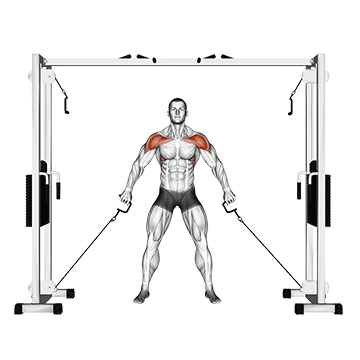
To perform the cable front shoulder raise, start by setting the pulley at the lowest level on the cable machine. Stand facing the cable machine and grab the handle with your right hand. Your palm should be facing your body.
Ensure your feet are shoulder-width apart for stability. Keep your back straight, your core engaged, and your arm fully extended. This is your starting position.
Slowly lift the cable handle in front of you while keeping your arm straight. Continue to lift until your arm is slightly above parallel to the floor. Ensure that the movement is controlled and that you're not using your back or momentum to lift the weight.
Pause for a moment at the top of the movement, then slowly lower the handle back to the starting position.
Repeat this movement for your desired number of repetitions. Once you've completed your set, switch to your left hand and repeat the exercise.
Remember to keep your core engaged throughout the exercise and avoid using your back or other muscles to lift the weight. The focus should be on your delts.
This exercise can be performed in sets of 10-15 repetitions, depending on your fitness level and the weight you're using. Always ensure you're using a weight that allows you to perform the exercise with proper form.
cable front raise
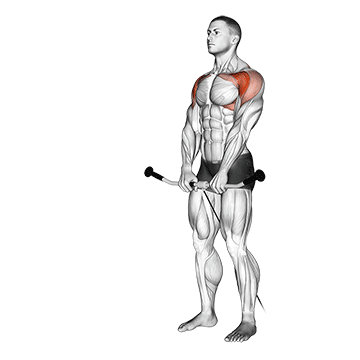
1. Start by setting the cable machine to the lowest height and attach a straight bar or D-handle to the cable.
2. Stand facing the cable machine, feet shoulder-width apart, and grab the handle with both hands. Your palms should be facing your body and your arms should be fully extended.
3. Keep your back straight, chest up, and your core engaged. This is your starting position.
4. Slowly raise the cable handle in front of you while keeping your arms extended. Continue to lift until your arms are slightly above parallel to the floor. Ensure your wrists remain in line with your forearms and avoid using your back or swinging your body to lift the weight.
5. Pause for a moment at the top of the movement, then slowly lower the handle back to the starting position.
6. Repeat for the desired number of repetitions.
Remember to keep the movement controlled, focusing on the contraction of your deltoid muscles. Avoid using too heavy a weight that could compromise your form.
cable forward raise
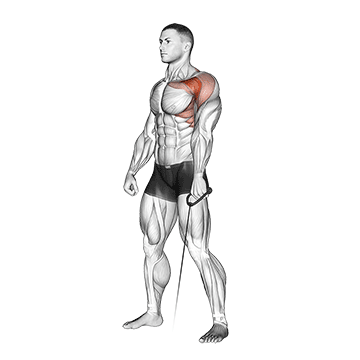
To perform the cable forward raise, start by setting the cable machine to the lowest height. Attach a straight bar or D-handle to the cable machine. Stand facing the cable machine, feet shoulder-width apart, and grab the handle with both hands. Your palms should be facing down.
Begin with your arms fully extended and the handle at waist level. Keep your back straight, chest up, and engage your core. This is your starting position.
Slowly raise the handle in front of you while keeping your arms extended. Continue to lift until your arms are parallel to the floor and in line with your shoulders. Ensure your wrists are straight and your hands are at shoulder level. Pause for a moment at the top of the movement.
Slowly lower the handle back to the starting position in a controlled manner. This completes one repetition.
Ensure that your torso remains stationary throughout the exercise and the movement is only happening at your shoulders. Avoid using your back or swinging your body to lift the weight. The focus should be on your delts doing the work.
Perform the recommended number of repetitions and sets for your fitness level. Remember to breathe in as you lower the weight and breathe out as you lift.
cable cross-over revers fly
1. Start by adjusting the pulleys on the cable machine to the highest level. Attach a handle to each pulley.
2. Stand in the middle of the cable machine, facing away from it. Grab the handles with each hand, ensuring your palms are facing forward.
3. Take a step forward to create tension in the cables. Your arms should be extended out to your sides, slightly bent at the elbows, and parallel to the floor. This is your starting position.
4. Keeping your torso stationary and your elbows slightly bent, pull the handles across your body and in front of you. Your hands should meet or cross over each other at the peak of the movement.
5. Squeeze your shoulder blades together and hold for a second at the peak of the movement.
6. Slowly reverse the movement, allowing the cables to pull your arms back to the starting position.
7. Repeat for the desired number of repetitions.
Remember to keep your back straight and your core engaged throughout the exercise. The movement should be controlled, focusing on the contraction and stretch of the delt muscles. Avoid using your body momentum to pull the handles, as this can lead to injury.
cable alternate shoulder press
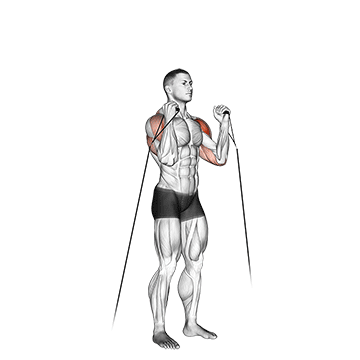
To perform the cable alternate shoulder press, follow these steps:
1. Start by setting up the cable machine with the handles at shoulder height. Stand in the middle of the cable machine with your feet shoulder-width apart.
2. Grab the handles with your palms facing forward and elbows bent at a 90-degree angle. This is your starting position.
3. Push one handle upward until your arm is fully extended. Keep your core engaged and make sure your back is straight throughout the movement.
4. Slowly lower the handle back to the starting position while simultaneously pushing the other handle upward.
5. Continue alternating between both arms for the desired number of reps.
6. Remember to keep your movements controlled, don't let the weights control you.
7. Make sure to keep your shoulders down and back throughout the exercise to target your delts effectively.
8. Repeat for the desired number of sets.
This exercise is great for working your deltoids and can be incorporated into any upper body workout routine.
No tags for this post.
